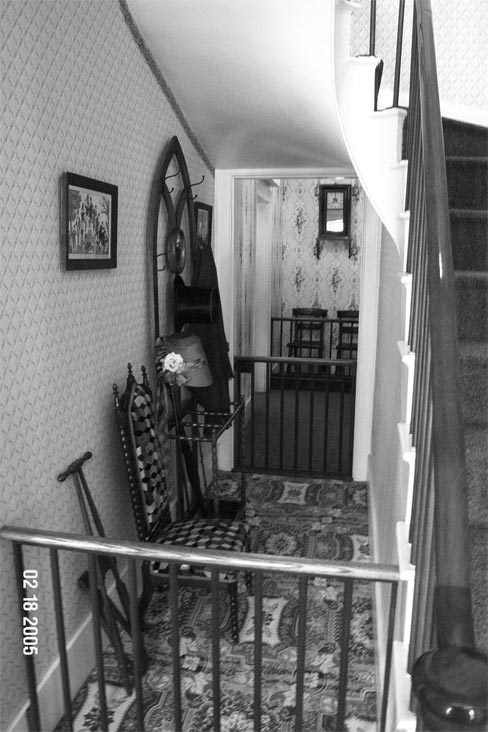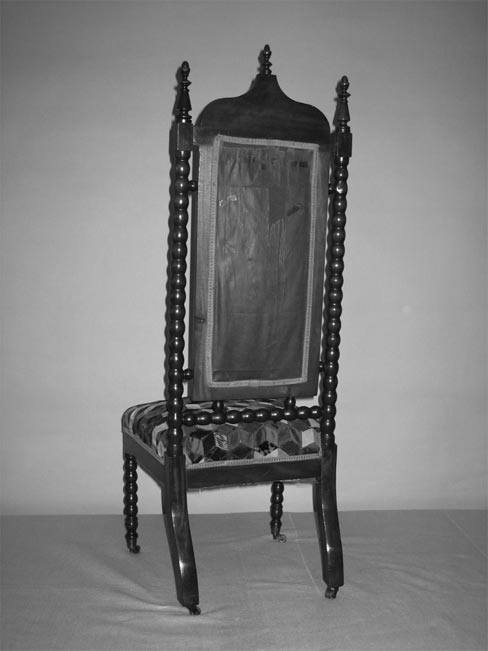Research Report
The Return of the Hall Chair to Lincoln Home National Historic Site
by Susan M. Haake
In January 1861, President-elect Abraham Lincoln and his wife Mary were preparing to move from Springfield, Illinois, to Washington, DC. Knowing they would not need most of their furnishings in Washington, the Lincolns planned to store selected pieces, give away others to friends and relatives, and sell the rest. A few days before the sale, Newton Bateman, Springfield's superintendent of schools for several years, stopped by Lincoln's downtown law office and asked Lincoln if he could have a few items before the sale. Lincoln invited Bateman to stop by the house that evening and take his pick. Bateman took two of the first pieces of furniture visitors would have seen when they entered Lincoln's home, a hat rack and chair.(Figure 1)
 |
Figure 1. This photograph shows the Lincoln hall chair and its companion, the hat rack, in position at the Lincoln Home. (Courtesy of the National Park Service.) |
Nearly 100 years later, in 1950, Newton Bateman's granddaughter returned the hat rack to the Lincoln Home. According to a contemporary newspaper article, the Bateman family had always planned to return the items to the Lincoln Home when they "were through with them."(1) The State of Illinois, by then the owner of the property, was about to launch an extensive restoration of the entire building. The caretakers were happy to place the hat rack in the home once the restoration work was completed. The chair, however, remained with the Bateman family.
Years passed, the Lincoln Home became a national historic site in 1972, and the chair remained at large. National Park Service furniture conservator John Brucksch, who had worked on nearly all of the Lincoln-associated furniture when the home was again under restoration in 1988, made it his informal, decade-long quest to get a similar chair for the front hall. The big break came in June 2001, when Brucksch received an unusual and completely unexpected letter stating that it was the writer's "wish to return the chair that Abraham Lincoln gave to my great grandfather, Newton Bateman, to the Lincoln home."(2) The Lincolns' hall chair was finally coming home.
Well, almost. Based on the photographs of the chair that accompanied the letter, the National Park Service determined that the chair needed some significant restoration work. Brucksch arranged to transport the chair from Connecticut to the National Park Service's Harpers Ferry Center in West Virginia for conservation. The National Park Service accepted the chair as a donation on December 21, 2001, when Brucksch picked it up.
Made in the American Gothic revival style popular in the Midwest from 1840 to 1850, the 44-inch high chair had what appeared to be a walnut frame with turned finials and an arched crest back.(Figure 2) Ball turnings accentuated the front legs and stiles. The back and seat were covered with modern upholstery, but Brucksch and his colleagues believed that the original upholstery lay underneath. The seat may have had the original springs, and the four legs were still supported by brass casters. Conservation of the chair began in October 2002, once Lincoln Home National Historic Site had secured the estimated $15,000 in funding required to cover the cost of the work.
Textile conservators Jane Merritt and Deby Bellman first had to determine the condition of the original upholstery. They removed the modern upholstery and revealed the original fabric, which was a patchwork in a tumbling block quilt pattern. Much like a quilt, the fabrics were both solid and patterned velvets; the materials were wrapped around a paper pattern and hand-sewn. Gimp ribbon was used to edge the fabric, including a plain brown woven fabric on the reverse of the chair back.
The velvets were worn, faded, soiled, and frayed. Tears along the corners and seams exposed the paper patterns underneath. The gimp had faded around the seat and was "shredded along the front edge."(3) The casters were tarnished, and one of them was bent. One of the finials was broken and had been poorly repaired several times. The webbing for the seat support was broken in several areas and sagged below the bottom framing of the chair. The overall finish was dull. The proposed treatment called for removal of the modern upholstery, cleaning and stabilization of the original upholstery, identification of all the original fabrics, stabilization of the gimp trim, and development of a system to reinforce the webbing so that it would not show below the chair framing.
The conservation team covered the worn places in the fabric with Stabilex, repaired the gimp trim, and created a detailed key, with photographs, that identified each of the 31 different velvets used in the upholstery.(Figure 3) Bellman dyed fabric to repair the covering on the back of the chair and suggested custom-fit dust covers to help preserve the delicate silk velvet fabric. A time period-appropriate green checked fabric was chosen for the dust cover. Separate covers were made for the back and seat to lessen the possibility of additional wear on the original fabrics when putting on or removing the protective dusters.(4) Next, the team stabilized or replaced the webbing under the seat and retied the springs into their original compression, which relieved the stress on the original webbing. An acrylic support was cut to fit over the webbing and attached to the chair frame with small brass tacks to provide support for the webbing and springs.
 |
Figure 3. These photographic details were part of a key used to recreate the fabric for the Lincoln hall chair. (Courtesy of the National Park Service.) |
With the webbing stabilized, it was time to send the hall chair to conservator Al Levitan in the furniture lab. The proposed treatment included surface cleaning, covering abrasions and applying a thin coat of shellac over them, removing old adhesive residue from one finial and re-adhering it, fixing a split in a front leg and a break in a rear leg, removing the corrosion from the brass casters, and applying a protective coat of paste wax over all finished surfaces. Because the chair had been refinished several times, the use of a mild abrasive to get at the deep-set grime fell in line with conservation standards. All work done on the chair, and the materials chosen, were reversible.
Harpers Ferry Center staff not only cleaned and repaired the chair, but also took documentary photographs and produced condition and other reports. The only major change in the initial analysis of the hall chair was about the wood used. It was thought that the hall chair was constructed of walnut, but after cleaning, the would-be walnut was revealed to be mahogany.
The hall chair arrived in Springfield on February 8, 2005. Because Lincoln's birthday is February 12, the chair was considered a great "birthday present" for the park. It was exhibited in the visitor center during the birthday events before returning to the front hall, next to its long-time companion, the hat rack. After almost exactly 144 years, the hall chair was home again.(5)
About the Author
Susan M. Haake is a curator at Lincoln Home National Historic Site in Springfield, Illinois.
Notes
1. Springfield Illinois State Journal, May 1, 1941.
2. Jane Ewart McCall to the staff curator, Division of Reference Services, Harpers Ferry Center, June 20, 2001.
3. Deby Bellman and Jane Merritt, "Object Condition Report and Treatment Proposal—Chair, American Gothic Revival" (proposal), June 11, 2003, Harpers Ferry Center Textile Conservation Lab, Harpers Ferry, West Virginia.
4. Since there is no evidence that the Lincolns used dust covers on their furniture, the park staff decided to use the dust covers only when the chair is in storage. For the short time the chair is on exhibit, the original upholstery is visible.
5. The chair is exhibited in the Lincoln Home for short periods annually, beginning on Lincoln's Birthday, February 12. Due to potential stress on the artifact caused by the front door being opened every five minutes for tours, the chair is no longer exhibited next to the door in the front hall but is instead in an upper hallway in Mary Lincoln's sewing area. A photo of the chair being worked on in the furniture lab is featured on the Harpers Ferry Center website at http://www.nps.gov/hfc/products/cons/con-lab-wood.htm, accessed on October 4, 2007.

